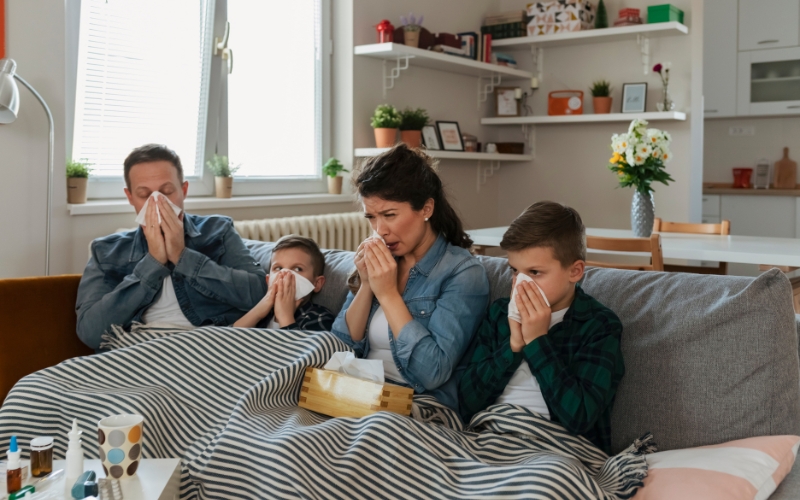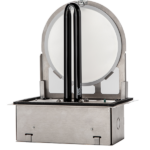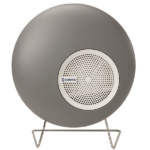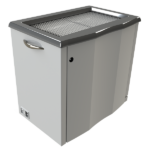Seasonal allergies can turn the joys of spring into a struggle against symptoms that just don’t quit. We all know the feeling – sneezing, congestion, itchy eyes, and more. Outdoor allergens like pollen take the blame, and rightfully so, but indoor air quality (IAQ) and allergies also have a connection.

Indoor Air Quality and Allergy Symptoms
If you’re reading this, you probably already know about how indoor air quality can be compromised. Dust, pet dander, mold spores, Volatile Organic Compounds (VOCs) are all culprits. And when these allergens take over the air, they can trigger allergic reactions to those who are susceptible. During the seasonal transitions, such as one from winter to spring (hmm…seems timely), the combination of the outdoor issues with existing indoor allergens can be brutal for those who suffer with allergies.
High humidity can exacerbate issues with indoor air quality and allergy symptoms quite a bit. Dust mites thrive in humid environments, and mold levels can rise in those higher-humidity indoor spaces. When they linger in the air, they irritate the respiratory tract and can trigger inflammation in the nasal passages and airways. Congestion, sneezes, coughs, and trouble breathing almost always follow.
How Poor Indoor Air Quality Fuels Allergies
Infiltration of Outdoor Allergens
Pollen, mold spores, and other outdoor allergens can find their way indoors through open windows, doors, and ventilation systems. Think about springtime and the air outdoors. Many want to get those windows open to enjoy it. It can cause issues. Once the allergens come indoors, they combine with the existing indoor allergens and intensify allergic reactions.
Humidity-Induced Allergens
As we mentioned above, dust mites and mold thrive in humidity. Often, indoor environments can be higher in humidity, especially in slightly crisper outdoor air.
Continuous Exposure
While outdoor allergens ebb and flow, indoor allergens, without any system in place, will persist. Prolonged exposure further aggravates the reactions, which makes it difficult for those who suffer from allergies to find respite.

Indoor Air Quality, Allergies, Productivity, and Mental Health
The good news is that working to alleviate allergy systems by improving IAQ is something that impacts far more than allergies. Keeping humidity levels lower, between 30 and 50%, can help to mitigate indoor allergens. But utilizing a technology like Synexis Dry Hydrogen Peroxide (DHP®) is also a very viable solution for almost any building. Whether looking to protect a few people or many, allergies can be a big cause for a loss of productivity.
According to a study, 52.7% of workers with allergy issues miss at least one day of work due to illness, compared to 41.2% of workers without allergies. The study showed that 3.5 million work days in the United States are lost to allergic rhinitis annually. Much of the loss of productivity even goes beyond missing work, but rather from reduced productivity.

Additionally, there’s a correlation between seasonal allergies and mental health. That may seem a little odd, but Dr. David A. Guids, chief of the division of rhinology and anterior skull base surgery at New York-Presbyterian/Columbia University Irving Medical Center notes that whenever someone doesn’t feel well, it’s a psychological stressor on the individual. But there’s more to it.
Experts believe inflammation is also to blame. Think about this scenario: for a person allergic to tree pollen, that means the pollen reaches the membrane that lines the nose, which prompts the immune system to release substances that can create inflammation.
“Among these substances are proteins called cytokines, which the body produces to fight certain infections,” said Dr. Todd Gould, professor of psychiatry at the University of Maryland School of Medicine. “These cytokines activate areas of the brain that regulate depression and anxiety.”
This isn’t to say that allergies are guaranteed to cause mental health issues or missed work time. But utilizing the right technology to at least help improve the IAQ goes a long way toward showing anyone who enters a building that the owners care. Addressing these issues through proactive measures can create a healthier indoor environment to help people find relief from their symptoms even at the worst of times.
Recognizing the impact of poor indoor air quality on allergies underscores the importance of prioritizing indoor air quality for overall health and well-being. The right approach can help allergy sufferers breathe easier and enjoy more comfort.
To chat with an IEQ specialist about the brand-new Sentry XL, click here to fill out your information.
To learn more about Synexis, click here.

















